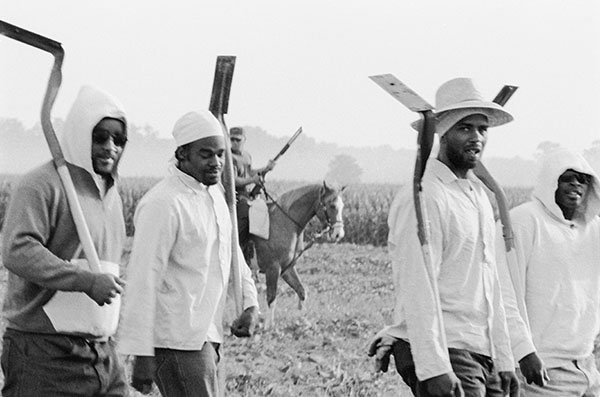Slavery, The Prison Industrial Complex: Photographs by Keith Calhoun and Chandra McCormick
From June 16, 2019 — October 27, 2019
For more than 30 years, New Orleans-natives Keith Calhoun (b. 1955) and Chandra McCormick (b. 1957) have been documenting life in the Louisiana State Penitentiary at Angola. Known as “The Farm,” the prison was founded on the consolidated land of several cotton and sugarcane plantations. Slavery, The Prison Industrial Complex includes poignant photographs and videos that record the exploitation of men incarcerated in the maximum-security prison farm while also showcasing their humanity and individual narratives. The exhibition sheds light on the cracks within our country’s criminal justice system and restores visibility to a population often forgotten by the public at large. The artists’ intimate understanding of prison culture and the importance of intervention before incarceration has prompted them to advocate on behalf of individuals directly involved with correctional facilities as well as in their own New Orleans community, where they teach photography to at-risk youth. Baltimore’s presentation will feature works not included at previous venues, including new photographs and videos honoring Gary Tyler and Norris Henderson, exonerated formerly incarcerated men who have achieved major civil rights breakthroughs in the struggle against mass incarceration. Calhoun and McCormick’s work is represented in private and public collections and has been widely shown in solo and group exhibitions at such institutions as the Contemporary Art Center in New Orleans, the Brooklyn Museum, and at the 2015 Venice Biennale. The New York Times, The New Yorker, and National Geographic are among the many publications who have written about the artists. The exhibition catalog, Louisiana Medley, features an overview of the artists’ careers by Frist Museum of Art Executive Director Dr. Susan H. Edwards and an essay by Dr. Makeda Best, Richard L. Menschel Curator of Photography at Harvard Art Museums.
This exhibition was organized by the Frist Art Museum, Nashville, TN, and curated by Katie Delmez and Susan H. Edwards, PhD. It is organized in Baltimore by Associate Curator of Prints, Drawings & Photographs Leslie Cozzi.
This exhibition and related programs have been made possible by contributions from Ellen and Ed Bernard and the Open Society Institute-Baltimore in honor of Sue Cohen, a fierce advocate for equity and the arts, and longtime supporter and Board Member for both the BMA and OSI-Baltimore. OSI-Baltimore is also working closely with BMA staff to create programming to tie the exhibit to issues of mass incarceration and criminal justice reform in Maryland.
Get Informed
- According to market research firm IBISWorld, private correctional facilities were a $4.8 billion industry in 2014, with profits of $629 million. In 2018, the industry grew to $6 billion. Learn more about the effect of prisons on the U.S. economy.
- Read about the links between education, housing, healthcare, and incarceration in Baltimore.
- Is orange the new black? Learn more about the challenges facing incarcerated women, the fastest growing segment of the incarcerated population in the U.S
- Money well spent? Read the Justice Policy Institute’s report on the dollars and “sense” of Maryland’s state corrections system.
Get Involved
To learn more about local, grassroots non-profits working to shut down or lessen the effects of Baltimore’s prison system, visit:
Volunteering at Maryland Justice Project offers an opportunity to work with front-running advocates for the rights of formerly incarcerated citizens. Volunteers are instrumental in planning fundraising events and coordinating projects that empower young people in the political process.
Out for Justice, Inc. is an organization comprising individuals directly and indirectly affected by the criminal justice system who advocate for the reform of policies and practices that adversely affect successful reintegration into society. Visit their website for information about upcoming meetings and volunteer opportunities.
For more than 30 years, New Orleans-natives Keith Calhoun (b. 1955) and Chandra McCormick (b. 1957) have been documenting life in the Louisiana State Penitentiary at Angola. Known as “The Farm,” the prison was founded on the consolidated land of several cotton and sugarcane plantations. Slavery, The Prison Industrial Complex includes poignant photographs and videos that record the exploitation of men incarcerated in the maximum-security prison farm while also showcasing their humanity and individual narratives. The exhibition sheds light on the cracks within our country’s criminal justice system and restores visibility to a population often forgotten by the public at large. The artists’ intimate understanding of prison culture and the importance of intervention before incarceration has prompted them to advocate on behalf of individuals directly involved with correctional facilities as well as in their own New Orleans community, where they teach photography to at-risk youth. Baltimore’s presentation will feature works not included at previous venues, including new photographs and videos honoring Gary Tyler and Norris Henderson, exonerated formerly incarcerated men who have achieved major civil rights breakthroughs in the struggle against mass incarceration. Calhoun and McCormick’s work is represented in private and public collections and has been widely shown in solo and group exhibitions at such institutions as the Contemporary Art Center in New Orleans, the Brooklyn Museum, and at the 2015 Venice Biennale. The New York Times, The New Yorker, and National Geographic are among the many publications who have written about the artists. The exhibition catalog, Louisiana Medley, features an overview of the artists’ careers by Frist Museum of Art Executive Director Dr. Susan H. Edwards and an essay by Dr. Makeda Best, Richard L. Menschel Curator of Photography at Harvard Art Museums.

Chandra McCormick. Men Going to Work in the Fields of Angola, 2004. Archival pigment print. Courtesy of the artist. © Chandra McCormick